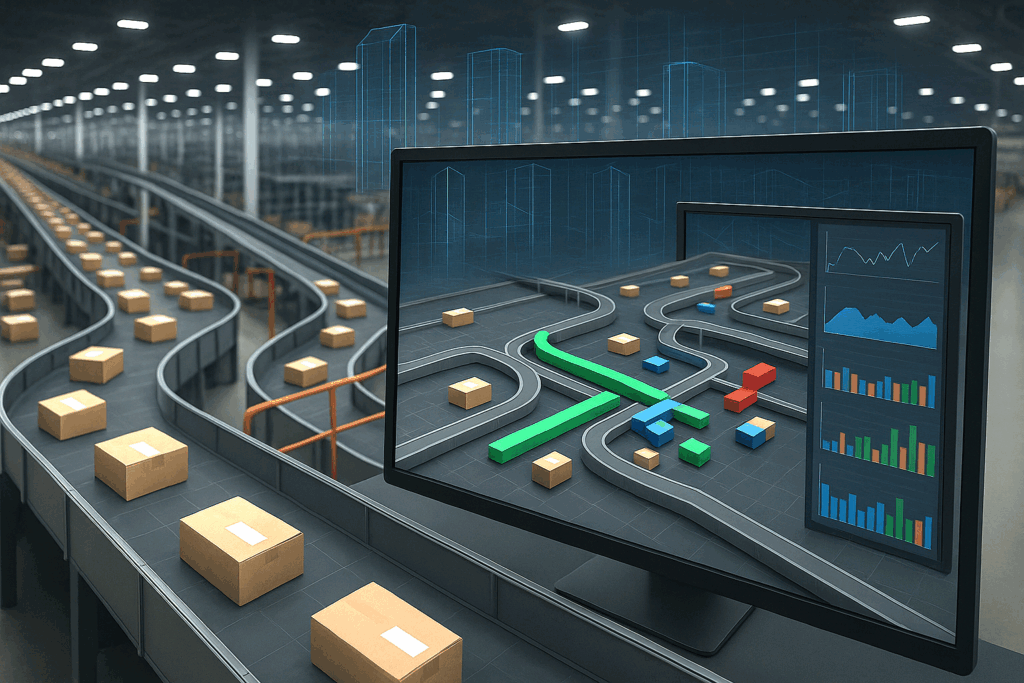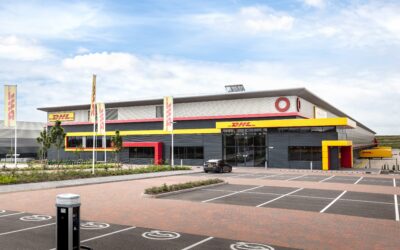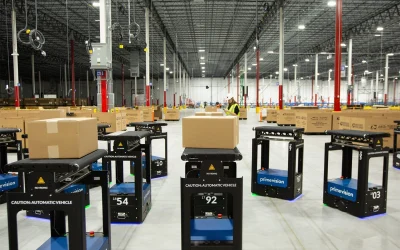As providers of postal services draw back on major investments and look to be more cost conscious, they are focusing on simulations of proposed changes to evaluate their impact. It is the time to address the small percentage improvements. Traditional methods of managing sortation systems, which rely on historical data and reactive maintenance, will no longer suffice. Enter digital twins and simulation tools: cutting-edge technologies that are transforming the way parcel sortation centers are planned, operated, and optimized.
Hans Jongebloed, Innovation Manager at Prime Vision, looks at how simulation tools can boost performance at parcel sortation centers.

A digital twin is a dynamic, virtual replica of a physical system, in this case, a parcel sortation facility. It uses real-time data and advanced simulation algorithms to mirror operations, test scenarios, and identify potential improvements. From simulating machine breakdowns to optimizing chute loading, digital twins are transforming how postal networks approach efficiency, productivity, and future readiness.
Perhaps the most strategic advantage of digital twins lies in their ability to guide long-term investment decisions. Rather than relying solely on historical KPIs or vendor promises, organizations can simulate how new equipment, facility expansions, or workflow changes would impact operations. Whether it’s adding a new sorter, expanding floor space, or integrating AI-based recognition systems, decision-makers can see the results before committing capital.
Planning for high parcel volumes
One of the most pressing challenges in the sortation industry today is dealing with unpredictable spikes in parcel volumes. Traditional forecasting models often struggle to deal with the level of variability encountered during holiday seasons when special promotions play a big part in public shopping habits. Digital twins offer a solution by providing a virtual testing ground for a wide range of volume scenarios.
Simulation software helps the operator set up a hypothetical scenario for their sorting center, and then historical or predicted loads can be used to study its behavior, giving more precise insights on what to expect from the operational change. Facility managers can identify potential bottlenecks, such as overloaded chutes, congested conveyors, or limited human resources, before these problems manifest in real time. This empowers them to take proactive steps, such as adjusting shift patterns, reprogramming sort logic, or even temporarily reconfiguring sorting zones.
In short, digital twins provide the visibility and foresight needed to maintain service levels during high-demand periods without costly trial-and-error approaches in the physical world.
Boosting efficiency and productivity
Beyond studying how a sorting center would handle a surge, digital twins are being used to optimize everyday operations. By simulating how parcels move through a facility, from unloading to final dispatch, companies can fine-tune conveyor speeds, tweak software parameters, and redesign layouts to maximize throughput. This leads to more parcels sorted per hour, reduced dwell times, and more efficient deployment of personnel.
For example, if the system identifies that certain chutes consistently fill up faster than others, operators can rebalance parcel flows or adjust assignment rules to prevent backups. Even small adjustments, such as modifying the spacing between parcels or tweaking the timing of diverters, can yield significant gains when scaled across millions of packages.

Simulating the unexpected
Unforeseen disruptions, such as power outages, floods or earthquakes, can cause major issues for a sorting network. They can necessitate significant ad hoc changes across the whole network. A simulation tool can help to quickly understand how best to reroute parcels and take over production from affected sorting centers.
On a smaller scale, machine breakdowns are an unavoidable reality in any automated environment. What makes digital twins so valuable is their ability to model the impact of these failures in advance. So, if a critical conveyor motor fails during peak hours, the likely effects can be visualized. Or, if a barcode reader stops working, the knock-on effects on the entire sortation chain will be highlighted.
A digital twin can simulate these scenarios and recommend alternative parcel assignments, allocation of personnel, or emergency shutdown protocols. This kind of virtual stress testing means facilities can develop and rehearse contingency plans with confidence. In doing so, they reduce downtime, minimize service disruptions, and safeguard customer satisfaction.
Smarter chute loading
Another common operational issue is chute overloading, which leads to inefficiencies and safety concerns. By continuously monitoring parcel flow and chute fill levels, a digital twin can simulate the effects of different loading patterns and suggest optimal sort schemes. This not only ensures smoother processing but also reduces manual handling and the risk of injury.
More advanced simulators can model the staffing of individual machines as well as accounting for different delivery times. They can consider the time taken for operatives to complete different tasks and therefore calculate the most efficient staffing levels for the expected volume of parcels at any time.
Labor shortages are also an ongoing challenge, particularly in the wake of global staffing upheavals. Digital twins help managers plan for such constraints by modelling operations under various staffing levels. They can identify which tasks are critical, which can be automated, and how resources can be redeployed to maintain output. This supports more resilient operations without compromising quality or compliance.
Updating legacy machinery
For larger organizations, running several sorting hubs, the machinery will often be sourced from various manufacturers operating with different software. This can require different sort plans to be developed for each plant, even using different languages, making for considerable inefficiencies.
Engaging with an expert in sorting technologies, such as Prime Vision, it is possible to develop common communications across all sorting machines and build them into the digital twin as well. Experts in software can create protocols to enable sorting businesses to select the best equipment and make sure it all communicates on the same platform.
Similarly, as equipment ages, the software becomes dated; up-to-date software could offer more functionality and features. Hardware typically has a service life of 20-30 years, software is more short-lived – so even older machines can be updated to current standards, such as 2D barcodes, and included in the simulation process.
Informed investment and future planning
Digital twins enable data-backed business cases for upgrades, demonstrating the return on investment (ROI) in measurable terms like reduced cost per parcel or increased sortation speed. This de-risks investment and supports agile, informed growth strategies.
As the parcel delivery landscape grows more complex, simulation tools and digital twins offer clarity in the chaos. They allow postal companies to anticipate problems, test solutions, and build smarter, more resilient operations. In a world where seconds matter and customer expectations are ever-increasing, these virtual mirrors could well become the backbone of modern logistics.




